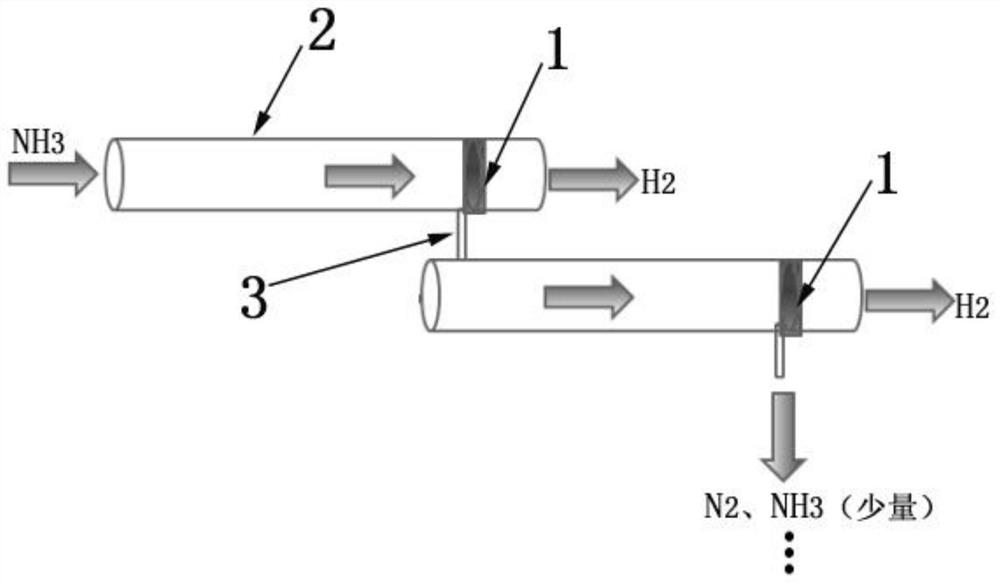A kind of high temperature proton membrane catalyst and its preparation method and application
A proton membrane, catalyst technology, applied in catalyst activation/preparation, chemical instruments and methods, physical/chemical process catalysts, etc., to reduce sintering problems, improve life, and improve activity.
- Summary
- Abstract
- Description
- Claims
- Application Information
AI Technical Summary
Problems solved by technology
Method used
Image
Examples
Embodiment 1
[0027] The preparation of high temperature proton membrane catalyst precursor includes the following steps:
[0028] 1) Weigh 3.487 g of samarium oxide and 3.442 g of cerium oxide, mix the samarium oxide and cerium oxide uniformly, and grind for 2 hours to obtain uniformly mixed samarium oxide and cerium oxide powder;
[0029] 2) The powder obtained in step 1) was calcined at a temperature of 500 °C for 12 hours in an argon atmosphere, and then cooled to room temperature naturally. The calcined product was ball-milled again to be uniform, and then shaken and sieved. The obtained powder was statically pressed and formed in an argon atmosphere. calcined again at 1200°C for 10 hours to form a solid solution, that is, to obtain a dense ceramic film;
[0030]3) Weigh 0.28g RuCl 3 Dissolve in 5.0 mL of deionized water to prepare the dipping solution, and evenly drop the dipping solution on one side wall of the ceramic membrane obtained in step 2) to make it saturated with water abs...
Embodiment 2
[0032] The preparation of high temperature proton membrane catalyst precursor includes the following steps:
[0033] 1) Weigh 3.258 g of lanthanum oxide and 2.092 g of germanium oxide, mix lanthanum oxide and germanium oxide uniformly, and grind for 3 hours to obtain uniformly mixed lanthanum oxide and germanium oxide powder;
[0034] 2) The powder obtained in step 1) was calcined at a temperature of 600 ° C for 16 hours in an argon atmosphere, and then cooled to room temperature naturally. The calcined product was ball-milled again to be uniform, and then shaken and sieved. The obtained powder was statically pressed and formed in an argon atmosphere. calcined again at 1500°C for 15 hours to form a solid solution, that is, to obtain a dense ceramic film;
[0035] 3) Weigh 0.22g RuCl 3 Dissolve in 5.0 mL of deionized water to prepare dipping solution A, and evenly drop dipping solution A on one side wall of the ceramic membrane obtained in step 2) to make it saturated with wat...
Embodiment 3
[0038] The preparation of high temperature proton membrane catalyst precursor includes the following steps:
[0039] 1) Weigh 3.365 g of neodymium oxide and 3.442 g of cerium oxide, mix the neodymium oxide and cerium oxide uniformly, and grind for 2 hours to obtain uniformly mixed neodymium oxide and cerium oxide powder;
[0040] 2) The powder obtained in step 1) was calcined at 800°C for 8 hours in an argon atmosphere, and then cooled to room temperature naturally. After the calcined product was ball-milled again, it was shaken and sieved. The obtained powder was statically pressed and formed in an argon atmosphere. calcined again at 1400°C for 10 hours to form a solid solution, that is, to obtain a dense ceramic film;
[0041] 3) Weigh 0.28g RuCl 3 ·3H 2 O was dissolved in 5.0 mL of deionized water to prepare an impregnating liquid, and the impregnating liquid was evenly drop-coated on one side wall of the ceramic membrane obtained in step 2) to make it saturated with wate...
PUM
 Login to View More
Login to View More Abstract
Description
Claims
Application Information
 Login to View More
Login to View More - R&D
- Intellectual Property
- Life Sciences
- Materials
- Tech Scout
- Unparalleled Data Quality
- Higher Quality Content
- 60% Fewer Hallucinations
Browse by: Latest US Patents, China's latest patents, Technical Efficacy Thesaurus, Application Domain, Technology Topic, Popular Technical Reports.
© 2025 PatSnap. All rights reserved.Legal|Privacy policy|Modern Slavery Act Transparency Statement|Sitemap|About US| Contact US: help@patsnap.com


